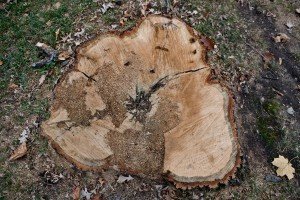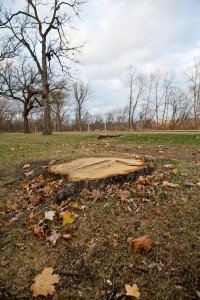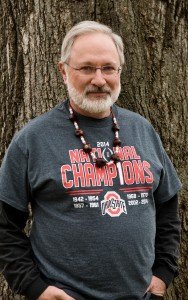 Article and photos by MARGIE O’LOUGHLIN
Article and photos by MARGIE O’LOUGHLIN
About a dozen red and white oak trees disappeared from the Longfellow River Gorge last month. The diseased trees had to be removed from the West River Parkway median between 36th and 38th streets, and the natural area called the Prairie Oak Savannah.
According to Ralph Sievert, Director of Forestry for the City of Minneapolis, oak wilt is spread in two different ways. Most commonly, the roots of an infected tree find the roots of a healthy tree underground. The roots graft, or join, and fungal spores pass to the healthy tree.
There’s only one way to stop this underground transmission, and it’s no small undertaking. Hire an arborist to trench around the drip line of diseased trees with a five-foot vibrating blade, severing any underground connection.
Oak wilt is also spread by an insect called the Picnic Beetle, which deposits fungal spores on open wound sites. For this reason, oaks should only be pruned during dormancy (Dec. 1 - Mar. 1.) If an open wound is created outside of these months through storm damage or accident, Sievert advised spray painting the wound to seal it shut.
Some homeowners choose to have their oaks preventively inoculated. A fungicide is injected into the root flare at the base of the trunk. As with trenching, this procedure should only be done by a certified arborist or tree service.
 When an oak is infected, the fungal spores clog its vascular system—meaning that water and nutrients can’t move up or down the trunk. Leaves begin to turn unseasonably bronze at the edges. Once this occurs, an oak can wilt completely in less than six weeks.
When an oak is infected, the fungal spores clog its vascular system—meaning that water and nutrients can’t move up or down the trunk. Leaves begin to turn unseasonably bronze at the edges. Once this occurs, an oak can wilt completely in less than six weeks.
Regarding boulevard trees, Sievert was quick to say, “don’t panic!” While it is significant to lose a beloved tree on personal property, widespread oak wilt on Minneapolis boulevards is unlikely.
Sadly, the risk of tree loss to oak wilt is much higher in parks and natural areas, where they grow close together. With a staff of 76 full-time employees and a budget of 9.6 million dollars, the Forestry Department is doing its best to stay ahead of this problem—and many others.
When dealing with tree diseases, some battles are won, and some are lost. Minnesota has the highest concentration of ash trees in the country, and they’re also under attack. Sievert estimated there were 30,000 ash trees on boulevards and 10,000 in parks before the Emerald Ash Borer arrived here.
This beguilingly beautiful insect is bright metallic green and measures ½” in length. The City has elected not to treat for Emerald Ash Borer but instead is acting on an “Ash Canopy Replacement Plan,” whereby 5,000 ash trees will be removed and replaced every year for eight years.
Replacement species include Kentucky Coffee, River Birch, Dawn Redwood, Bald Cypress, Prairie Gem Pear, Swamp White and Bi-Color Oak. Disease-resistant elms are also being introduced back onto Minneapolis boulevards with varietal names like Accolade, Triumph and New Horizon.
 Maples have been suspended as a choice for boulevard planting. Sievert said. “About 25% of our boulevard trees are currently maple and, if there’s one thing we’ve learned in the last several years, it’s to avoid a dominant planting. We want diversity.”
Maples have been suspended as a choice for boulevard planting. Sievert said. “About 25% of our boulevard trees are currently maple and, if there’s one thing we’ve learned in the last several years, it’s to avoid a dominant planting. We want diversity.”
Photo left: Ralph Sievert, Forestry Department Director, standing in front of a Burr Oak.
“Some blocks in Minneapolis have nothing but ash trees,” Sievert noted. “In those cases, we’ll remove a handful each year, replacing as we go. That way the loss isn’t so devastating and some of the trees will have gotten a good start when the last of the ash trees have to go.”
Currently, the City is marking ash trees in three different ways. “The green plastic ribbons are part of an awareness campaign,” Sievert said. “We want people to understand which trees are ash, and which are not.”
If an ash tree is painted with a green ring, that means the tree is already infested with the Emerald Ash Borer. If a green “X” has been painted on a tree, it’s slated for removal.
The Emerald Ash Borer is yet another in a long list of invasive species changing our landscape. It’s thought to have entered the US in Detroit MI, arriving from China on shipping palettes made from infested wood.
Homeowners may elect to treat ash trees on their property at their own expense. According to Sievert, the cost is about $10 for every diameter inch of trunk. That means that for a 20” diameter tree, the cost (every 2-3 years) to inoculate would be about $200. Check the U of M Extension website for tips on how to choose a certified arborist at www.umn.edu.
Even with the waves of tree diseases that have hit South Minneapolis over the years, Dutch Elm Disease and Emerald Ash Borer being among the worst, we still have an abundance of trees in our urban forest. Sievert estimated that our tree-lined city boulevards extend for 1,100 miles—stretching the equivalent of from here to New York City.
Comments
No comments on this item Please log in to comment by clicking here